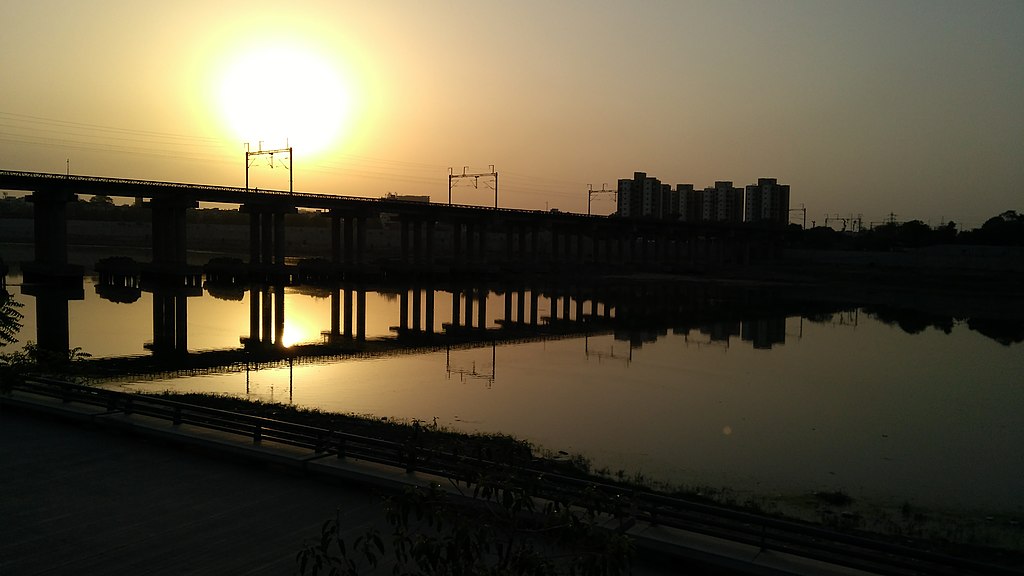
A study published in the Journal of Remote Sensing and Space Sciences, analyzing the cooling effect of the city of Ahmedabad’s water bodies, has thrown up some interesting findings. The east bank of the Sabarmati river, which flows through Ahmedabad, was found to be significantly cooler than the west bank, witnessing a greater drop in temperature even during summer. The study provides direct evidence of how water bodies affect temperature variations.
The Sukhna lake in Chandigarh and the Sabarmati river in Ahmedabad were taken up in the study, to assess the variations in microclimate near these water bodies. Urbanization has resulted in the conversion of the natural land cover into impervious surface materials such as concrete, asphalt and metals. Besides anthropogenic heat, lack of green vegetation cover and water bodies leads to release of excess heat, resulting in the urban heat island phenomenon.
The high heat capacity of water forms a “thermostat effect”, which in turn creates a cooling effect around surface water bodies like ponds, lakes and rivers. Also, high evaporation produces a noticeable “oasis effect” around water bodies, decreasing nearby surface and air temperatures.
The study observes the effect of the water bodies on land surface temperatures seasonally, using remote sensing data and GIS techniques. Directional analyses were conducted by creating buffer areas, thus determining the extent of cooling over these cities. Landsat images of the years 2009, 2010 and 2011 of 30-meter resolution were processed to produce the land surface temperatures of the study areas.
An appreciable average temperature dip of 7.51°C and 3.12?°C was observed during summer and winter for three years near Chandigarh’s Sukhna lake. Spread over 3 square kilometres, Sukhna Lake is surrounded by thick vegetation, which cools ambient temperatures by 4.5°C to 8.21°C as far as 1500 to 1800 metres away during summer. Cooling is in the range of 3.35°C to 3.6°C at 1200 to 1400 metres away in winter.
Ahmedabad and the Sabarmati river
Ahmedabad, the industrial capital of Gujarat and heart of the textile industry had a recorded population of about 5.57 million in 2011, and is expected to house about 10.5 million people by 2030.The average annual rainfall in the area is about 800 mm. The Sabarmati, a monsoon-fed river flows right through the centre of the city. In Ahmedabad, the width of the river varied from 300?metres to 425?metres. The study considered about 1.5?kilometres on either side of about 10.5?kilometres of the Sabarmati.
A timelapse of Ahmedabad city on Google Earth Engine from 1984 to 2018 clearly indicates that the radical alteration of land-use pattern has created microclimates where heat islands have developed.
Assessing land surface temperature changes in Ahmedabad
Land surface temperature is high as per the study for two out of the three years, either due to the presence of industries on the outskirts of the city or because of open fallow land and its soil property therein. During the summer, the urban heat island pattern is not at all evident, while a low-intensity urban heat island pattern appears in winter during the day time.
The temperature fell by about 1.61°C from the river bank up to 200 metres, and it fell by 1.82°C from the bank up to 300 metres during winter, over the entire study duration. The temperature is low within 200 metres of the river bank and shows a sharp ascent there onwards. When moving towards the river, the drop in temperature starts from 500 metres to the bank and is significant within 100 to 300 metres of it. Hence, effective cooling is prominent within 300 metres, extending up to 500 metres from the bank approximately. Beyond this, no cooling is observed due to the river.
The rising temperature beyond the influenced distance on the eastern side of the city (right bank) may be due to the presence of the old walled city comprising a congested network of roads, commercial and residential areas. Such highly dense built-up areas cause an increase in the imperviousness and alterations in the urban morphology, i.e., the structure and the pattern of roads and buildings obstruct the cool wind blowing from the river.
On the left bank, the temperature is influenced within a range of 100 to 400 metres. The average drop in temperature near the left bank is about 0.78 °C (within 300 metres) and 0.59 °C (within 200 metres) during the summer. The temperature fell about 0.55°C from the bank up to 200 metres and 0.75 °C from the bank up to 300 metres during winter, across the duration of the entire study.

The undulation seen in the western part of the city while moving from the left bank may be because of the presence of open spaces in that part of the city in the form of parks, gardens and open grounds, which compensate the rise in temperature.
According to the study, Ahmedabad’s typically sandy loam soil quickly heats up during peak hours of the day and cools down rapidly towards the evening. The weak urban heat island pattern may also be because of the Sabarmati river flowing through the city center. The water acts as a heat moderator because of the high latent heat of vaporisation and heat storage capacity as compared to land parts. The actual reason behind such behaviour is not clear yet, as it is influenced by a variety of factors, the authors observed.
The study points out that while water bodies do combat high temperatures in urban areas, the effect is more when combined with vegetation or parks. The Sabarmati riverfront, an enormous infrastructural project, has already reduced the river width from 425 to 300?metres, thereby reducing its cooling potential. All such constructions lead to new impervious surfaces near the river bank, which caused the rise in overall surface area temperature.
Surface water bodies present in an area arguably have the potential to mitigate the effect by providing a perspective cooling through evaporation, thereby reducing the heating effect. City planners and architects should continue to use water bodies as essential design tools for scientific planning to control rising urban temperatures.
The full paper can be viewed here